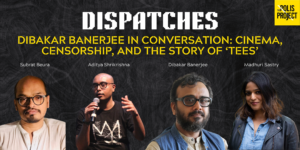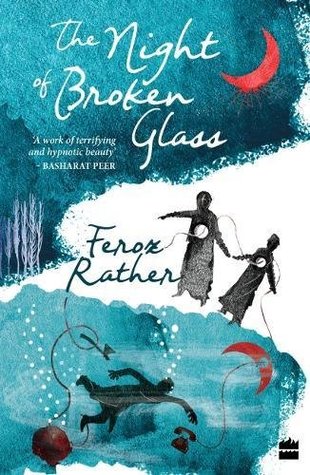

Feroz Rather departs from the territory of realism and plunges into the abyss that is the pain and the crisis of existence in an occupied land

The Night of Broken Glass breaks new territory in the space of creative writing about Kashmir, but falls short on providing any new, definitive insight into the collective psyche of trauma and chaos engendered by occupation. Taking its cue from the narrative of Holocaust writing, it strives to observe the creation of memory through testimony and further employ language as a testimony, departing from the tradition of journalistic realism that has come to define much of Kashmiri fiction writing. This departure permits the book to explore occupation as a metaphor for existential crisis engendered by occupation with a psychotic intensity, but suffers from a lack of fresh insights into understanding the contingencies of everyday life in Kashmir beyond what is already known, and experienced.
The thirteen interlinked chapters in the novel double as short stories, more effectively at that, narrated in different styles—some narrated in first person, like Rosy, while others in the ubiquitous third. The characters, naturally, recur across the stories. Some of them progress—like the rebellious stone-pelting Tariq, the cynic cobbler Gulam, or the permanent bêtes noires of a beleaguered population like Major S and Inspector Masoodi. But others just remain mere caricatures—like the conflicted-opportunistic boss, or the baker, Misreh, who is accorded little action except sexual liaisons without any insight into her motivation: she has an affair with Syed Aslam Shah, the scion of the firmly elite Shah family, as well as Gulam, a cobbler who belongs to the despised class of outcastes.
This contradiction mirrors the larger frame of the novel that vacillates between the likes of the ‘Pheran,’ a story largely predictable, and ‘Robin Polish,’ which startles by its fascinating exploration of relationship between a father and son who stand at opposite spectrums of class yet are joined by caste. The latter category fascinates while the former induces a feeling of familiar sadness that keeps you engaged just enough to soldier on.
The first story, ‘Old Man in the Cottage,’ for example, seeks to explore an existential conflict that rages on inside a man craving for revenge, after being wronged, incarcerated, beaten and left for death by Inspector Masoodi. The man gets his chance after years only to find Inspector Masoodi is now a wreck, dying of lung cancer as a lonely old man in a distant cottage. The motif of revenge is neither new—Papillon or the classic Count of Monte Cristo being classic examples—nor is the existential dilemma new—Hamlet built a reputation on his moral scruples. The story, therefore, hardly interests but is rescued by its exquisite descriptions.
Consider for example this poetic passage: “He panted outside, while his father coughed inside. All this panting and coughing seemed strangely ludicrous, both father and son in a state of utter helplessness, and for a moment there I nearly burst out laughing.” Similarly, consider this soul crushing description of torture that illustrates the inscription of physical pain upon the body and the collapse of the normative world it incurs: “The lake swelled, and the hills shattered to mounds of ash. I did not lose consciousness. I felt the pain.”
The victim’s intangible, normative world has been completely uprooted by the visceral reality of pain and, by consequence, fear. The simplicity and brevity of this sentence is a telling commentary of the violent upheaval that is the everyday reality of people in occupation. Such delicate parallelism lends the story a poignancy that rescues it from being a mere catalogue of a run of the mill revenge plot but the background of conflict and opportunism adds little by way of urgency or perspective to the story. It serves as a prop, not the raison d’etre as it is intended.
The story also introduces the two characters who form the glue that join the disparate strands of the narrative together: Major S, the symbol of the occupational army, and his local lackey, Inspector Masoodi, who represents the local collaborator and owes allegiance to the oppressor in lieu of privilege and power. Anti-heroes of the novel, their destinies determine and interweave the destinies of other characters and shape their lives. It’s a deft touch, the ironic power of trauma from occupation pointed out to forge a sense of unconscious community among the traumatized, as grief and confusion become the overarching primary identity.
‘The Pheran’ and ‘The Souvenir’ are good examples of this identitarian crisis, the latter more than the former, as they explain the contingencies of everyday life at a collective level while seeking the metaphoric kinship between military occupation and a claustrophobic occupation of the mind engendered by the fetishisation of survival and stability. ‘The Pheran’ attempts to explore this kinship by foregrounding it within a love story with Safir and Maryam, both journalists, as its protagonists. Maryam is the daughter of a retired clerk and works for the rather aptly titled Informer, headed by the boss who serves as the ears and eyes of the state. Maryam struggles with idealism and filial love, trying to balance a career with demands of being the mistress of the house. Her disillusionment with journalism is indicative of the everyday concerns and risks of being a journalist in a conflict zone, where the idiom is firmly set in the mode of reportage rather than analysis.
Similarly, Safir’s interview of Abdul Rashid, modelled after Muzaffar Wani—father of the famed militant leader Burhan and whose elder son Khalid was killed while carrying food for the rebel—is meant to showcase the elegiac tone of such reportage which must bring to light human rights abuses, tragedies of crushed dreams, shattered survivors, and the immense cost of war. Both narratives, however, carry a timeworn feel to them and hardly intrigue. If the story interests, it is on account of its subtle allusion to the decay of the old order, such as the diminishing returns of the Kozgar perfume shop.
The choice of the Royal Enfield over Yezdi also disconcerts a bit, as the latter was the one more likely to be used in 1990s when India had just begun liberalizing markets. The purchase of a Maruti by Ishfaq instead of the ubiquitous Fiat after years of saving alludes to this intrusion while the insistence of Boss to provide impersonal and crisp reports (because they sell better) reflects the collision of free market values with the more orthodox idea of responsible art. It is just as well that the story does no more than hint than succumb to the advantage of hindsight, as they create just the right tension that prevents the narrative from derailing.
‘The Souvenir’ conjures a morbid exploration of a young Tariq’s psyche as he is brutally initiated into the cult of violence. It starts with his fascination and horror with the sign of danger, skull crossed over two bones, and as he flings a stone at the sign one day in the hope of reassuring himself, misses the mark, and kills an unsuspecting pigeon. To his surprise, the world remains unaffected as the death goes unregistered, and unpunished. No traffic screeches to halt nor does anyone enquire, not even the shrine nearby, where the saint is interned, intervenes. Subsequently, he is forced by a soldier to shoot two more pigeons with a gun, the accuracy of his aim being remarkable for his age. And yet again the world remains unaffected.
The pigeons being metaphors for ordinary Kashmiris, violence is woven into the fabric of existence. The shrine loses its legitimacy as does the rosary in the eyes of the boy, representative of disillusioned youth and later a stone pelter. A rosary of bullets replaces the traditional one, and his room a shrine of revenge. Unwittingly, Tariq discovers the oxymoron of occupation—the master feeds and kills as well. The hand that feeds the pigeons also shoots them down to be roasted. The ironic relief in Tariq’s survival, without realizing his psychical death, is a frightening testimony of the transformative powers of conflict to desensitize and scar.
The novel is at its strongest when it deals with such symbolism. Like ‘The Nightmares of Major S,’ a powerful story that explores the double-edged nature of violence—it scars the perpetrator as much as the victim. Major’s recurring nightmares about the mutiny of grass that overgrows endlessly on a sunny March morning and of suddenly being dragged naked under an overcast sky into a grassy grave testify to his guilt and the gaping wound left on his soul by the killing and torture of innocents. For all its heady and aphrodisiac delights, power can extract a cruel price. Punishing anxiety of contamination and vulnerability haunts the occupier even as it seeks to dismiss the occupied. And then the terror of Time’s propensity effects mortality, vulnerability, and mutability, and the fear of this mutability embedded in his primeval consciousness now rises to the fore in his sleep and his wakefulness. Gradually, the fear will wear off, and the powerless will strike back and consume the state.
No wonder, the major hastens to pave the whole courtyard with sandstone, an assertion of his power to determine the flow of life by hollow bravado. There’s a distinct eco-critical overtone, occupation as a source of ecological destruction as the Major gets trees mowed down. The sandstone is aptly imported from outside, alluding to the vested interests of Indian business class in contributing to the deprivation of Kashmir. Similarly, ‘Robin Polish’ hints at the Major’s substance abuse problem, a common fallout of serving in conflict zones: “Major S turned to leave when he espied a box of shoe polish on the worktable. He picked it and sniffed it… sucked at his front teeth, making a hissing sound… examined the rim of the box closely, his tongue sticking out with intense concentration.” It is a damning attestation of the fact that occupation is vertigo. It spares none.
‘Robin Polish’ in fact strikes out, for it is a perfect microcosm of the book. At its heart, the story is about class conflict—Gulam is both bitter that his son Jamshid was separated from him as Syed Anzar Shah, the powerful cleric, chose him as his protégé, and proud that he was able to transcend the limitations of his outcaste ‘Watul’ birth and penury accompanying it. The interactions between the son and father make for some captivating reading and an excellent insight into the workings of class and caste in a supposedly casteless Muslim society.
Sample this passage where Ghulam is reminded of the time when he yearned to speak about the estrangement from his son and had begun reading the daily Chattan to suppress loneliness: “Thinking back to that time, his stomach roiled with the memory of the bitter solitude of those nights inside the room, where darkness mingled with silence and turned into a viscous, clingy substance that spread all over him, and permeated his skin to the morrow. He had trembled like a leaf. He had an intense desire to speak and be heard. To speak and be heard. He wanted to weep and be heard.”
The schizophrenic intensity of the moment, the no-holds-barred synesthetic visceral assault, and its free fall into different time spaces past and present is a powerful reminder of the silencing that class difference performs, and the trauma of being cheated out in the roulette of birth as one is born into the lower end of the social hierarchy. The story succeeds in pointing this out adequately, without the aid of the metanarrative of conflict, and only needs it to fill in the gaps and hurl the narrative towards a conclusion—the Bijbehara Massacre.
All in all, the novel is a welcome intervention in the discourse of writings on Kashmir, as it introduces a fresh narrative voice that seeks to privilege narration over content while seeking a harmonious relationship between the two. While it doesn’t exactly succeed in really startling the reader with particularly novel insights into a traumatized subjectivity or memory making, it does succeed in pointing out that the realistic mode is not the only way to realize them. Its defining strength is its attention to craft; even as it overshadows the narrative at times, at times it succeeds with great panache. The book must, therefore, be read and cherished as marking a welcome diversion on the literary scenario that can only lead to a flourishing of literature, especially written in English, from Kashmir even as the valley plummets further into gloom. If we are destined to misery, let its exhibition at least be a celebration.
The Night of Broken Glass by Feroz Rather , HarperCollins India, 2018.





